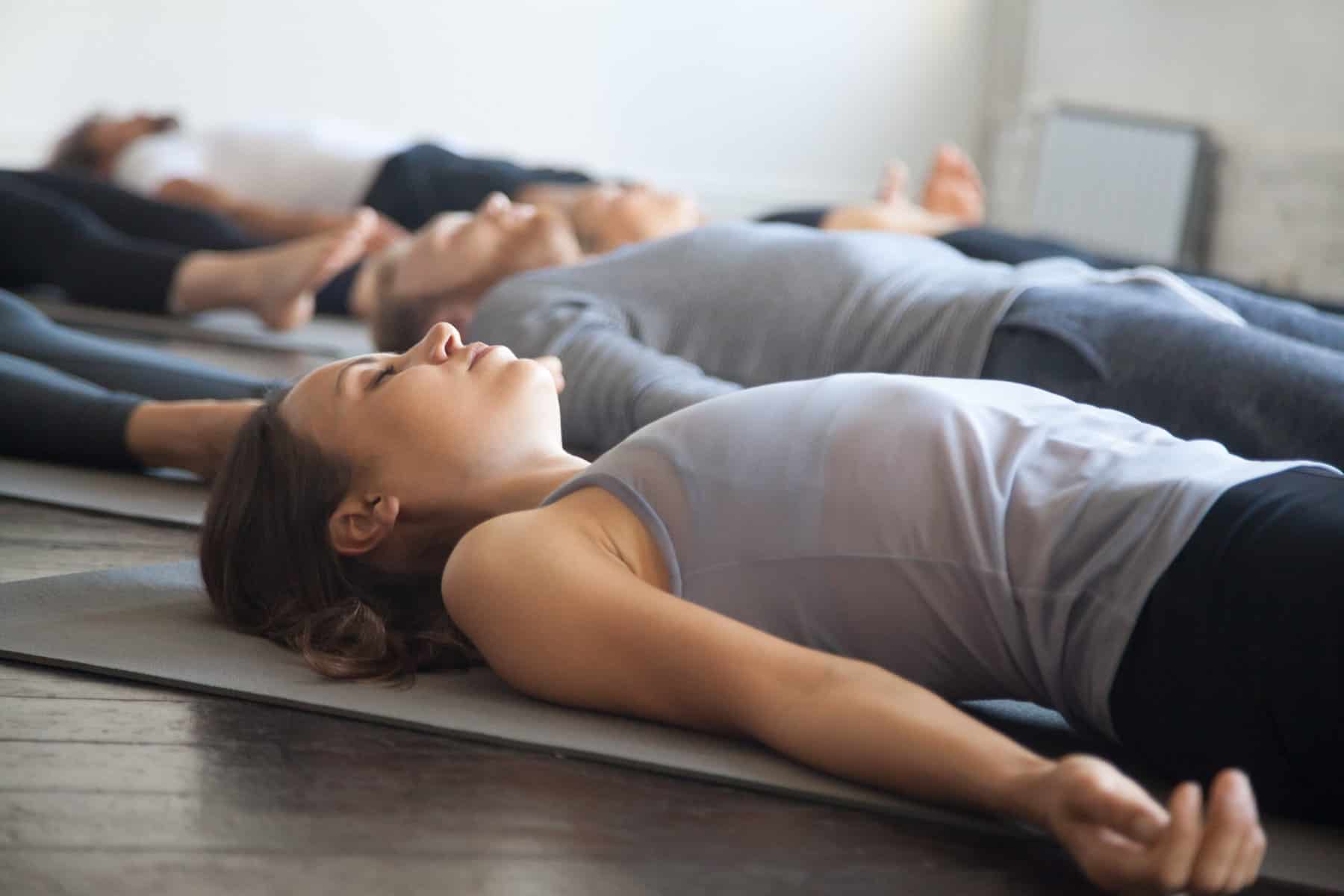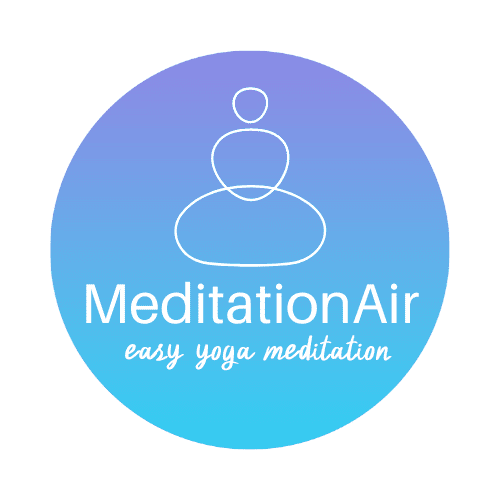Are you practicing yoga to improve your mind-body wellness?
Try adding some meditation in there to get even more benefits with these 3 easy ways:
Yoga and meditation have been widely recognized as powerful tools for self-care. Practicing both is the best path to connect with yourself – and ultimately lead a healthier life physically and mentally. Meditation can feel hard, though, if you’re new to it (or are just working your way into it). No stress. I’ll help you explore how to enhance mind-body wellness by combining yoga meditation and yoga in 3 super-easy ways. Experiment and see which one works for you.
Mind-body benefits of yoga
The practice of yoga is universally known for its physical benefits: better strength, balance, flexibility, and posture. As a result, yoga has been proven to relieve back and arthritis pain, and lower blood pressure, among many other positive things for the body.
The true beauty of yoga over other exercise types is the added elements of focused breathing and mental awareness of the way your body moves and feels in the present moment. Put all together, yoga becomes a powerful tool to connect mind and body.
Yoga teachers instruct you to breathe properly during the poses (asanas). This helps you ease into and hold asanas, especially challenging ones – you ‘breathe into’ the area of the body that needs support or loosening. But in the process, controlled breathing also serves to calm the nervous system, aiding in stress management. This translates into reduced anxiety and depression, lower blood pressure, and less inflammation, many studies show.
At the same time, learning to be mindful of the body’s movements and sensations during a yoga practice has effects off the mat too. It trains the brain to be mindful about caring for the body in everyday situations, like choosing what to eat or understanding your body’s cues about needing rest.
Over time, this mind-body connection becomes strong and automatic. You’re empowered to take an active role in your journey toward health and healing.
Meditation further enhances these effects by deepening our connection with our inner selves through stillness and focus on the present moment.

Mind-body benefits of meditation
In meditation, you achieve a much deeper form of relaxation than you can during an active yoga practice: When the body is moving, the mind cannot be fully still. Stilling thoughts in order to reach mental balance and calm is the goal of yoga meditation – although it can take some practice to get there. The mind-body benefits of meditation, however, are worth the effort.
While yoga has health benefits beyond the mere physical, meditation takes those mental benefits to the next level. Even after just 8 weeks, for instance, daily meditation is shown to affect brain function, positively impacting feelings of stress, empathy, and self-awareness. The spillover effects include stronger relationships, better sleep, and less fatigue.
Done over a longer period, meditation can reduce brain aging, which is key to maintaining cognitive function as you grow older, and raise emotional self-regulation, which helps in stress and weight management, among other things.
Source: Prevention Magazine
How to Enhance Mind-Body Wellness on the Mat
Combining yoga and meditation is the most powerful way to build resilience in mind and body. As I mentioned, if meditation is new to you, you’ll want to start easy…and easiest is adding meditation into your yoga practice:
#1 – Savasana
Everybody’s favorite part of yoga class, savasana (corpse pose), is the perfect time to try a short meditation. You’re already relaxing on the mat, probably feeling grateful you made it through the practice, and hopefully blissing out from good yoga vibes. Resist the temptation to doze off and instead do a body scan or a breath exercise.
For the body scan, begin at the top of the head and move down one body part at a time, taking time to focus on each area. Make sure you are releasing any tension there. Observe the feeling in each area – does it feel heavy and grounded, or light? Energized or fully at rest
If a body scan seems like too much work, try a simple exercise of counting during your inhales and exhales. Example: inhale to the count of 5, then exhale to the count of 5. This should stay relaxing, so keep the breath as long or short as feels good. Don’t worry if the inhale and exhale lengths differ.
#2 – Meditative Yoga
Some people refer to yoga as moving meditation, and that makes sense. In a perfect yoga practice, you are paying as much attention to the breath and awareness of your body as you are to following the exercises themselves. When it all flows, it can be a wonderful mind-body experience.
So in your next yoga session, set the intention to bring some meditation in, too. Try to focus on what’s happening in the moment, not thinking about what comes next (and definitely not looking at what your neighbor on the next mat is doing!). Are you holding your breath? Release it. What are your muscles and joints feeling right now? Can you open up any tension by breathing into it or sending energy there? Can you visualize a deeper stretch? The mind leads and the body follows.
Remember that this is your practice, so you can slow down, speed up, or adapt the pose to what suits you.
#3 – Quick Meditation Before Practice
Most guided yoga classes begin with a few minutes of quiet or reflection, maybe a mantra chant. This is also a chance to meditate! Follow along but also try to ‘be here now.’ When thoughts drift in about what’s happened that day, or what may happen later, wave them goodbye with a gentle smile and no judgment. Invite calmness into your body and mind.
You’d be surprised how quickly you can come into a calm, present state if you practice quick meditations like this regularly before yoga.
All 3 of these yoga meditation techniques have something in common: They train your mind to focus on the ‘now’, and they build self-awareness. Those are two of the best ways to enhance mind-body wellness.
Stress mostly builds when we think about past and future, and it tends to melt away if we only concentrate on what’s happening in this moment. And strong self-awareness empowers us to make positive choices about how we live and treat our bodies.
Add meditation to your yoga practice and you’ll find yourself feeling calmer yet energized at the same time. When combined and practiced regularly, these two ancient practices promote mind-body wellness that leads to healthy physical and emotional outcomes. The results are tangible – not only will you feel more relaxed with better clarity in your thinking, but also an overall sense of joy when you look back at how far you have come.
You may also like...
- Exploring the 5 Best Benefits of Meditation for Mind and Body: The Relationship between Meditation and Health Exploring the Benefits of Meditation for Mind and Body In today's fast-paced world, it can...
- Healing the Body Through Meditation – Does It Work? Is healing the body through meditation possible? Yes, and no. There’s ample research to show...
- Can Meditation Heal The Brain? 4 Ways It Works Can meditation heal the brain? Yes. Studies show that meditation can change the brain’s structure...
- Releasing Stress: Can Meditation Help Cancer Treatment? It's easy to imagine how releasing stress can be beneficial for anyone, but what if...


